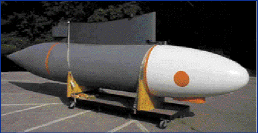
Wind-Profiling Lidar Betters Airdrop Accuracy
Ruth A. Mendonsa
The US Air Force Research Laboratory at Wright Patterson Air Force Base has taken another step forward in its efforts to improve the accuracy of high-altitude aerial delivery. The Airdrop Ballistic Winds team is testing and demonstrating what it calls the Operationally Capable Lidar (OCL), a system that features a notable improvement over its predecessors. It provides real-time, three-dimensional maps of wind fields from altitude to ground with range slices of less than 100 m and velocity accuracy to within 0.5 m/s.

The lidar wind-profiling system being tested by the US Air Force is mounted in the nose cone of a C-130 fuel pod.
The core of this system features -- as did its predecessors -- a Coherent Technologies Inc. laser designed for this application. The first-generation system was a flashlamp-pumped laser that produced 50 mJ per pulse at a 7-Hz pulse repetition frequency and was mounted over a scanner and window assembly behind the front landing gear of a C-141 aircraft. The second-generation system was a diode-pumped transceiver that produced 3.5 mJ per pulse at 200 Hz and was installed on a C-130 aircraft.
The new version is an eye-safe Tm:YAG, 2-µm monostatic diode-pumped laser transceiver that produces 12 mJ per pulse at 100 Hz. The transceiver, signal processing unit, environmental control unit, optical scanner, inertial navigation unit and power supplies are mounted into 18-in. racks within the nose cone of a modified fuel pod on a C-130. The factors enabling this placement are the reduced size and weight of the system hardware: The second-generation airborne lidar system's weight and volume were 2014 lb and 115 ft3; the new system weighs 600 lb and occupies 45 ft3.
Although the Air Force's primary objective for the fuel-pod lidar is to achieve real-time determination of ballistic winds for improved airdrop accuracy, it also will be used to collect high-altitude atmospheric backscatter data for validating current backscatter models and for designing future lidar systems. According to Airdrop Ballistic Winds Program manager John F. Carr, because the pod can be moved easily from platform to platform and C-130 aircraft are readily available, researchers will be able to engage in high-altitude phenomenology investigations and to develop the technology needed to explore the potential of solid-state laser radars.
Regarding a precision airdrop demonstration planned for Yuma Proving Grounds, Ariz., this month, "I believe the OCL will realize an improvement in airdrop accuracy of greater than two times," he said.
Published: September 1998